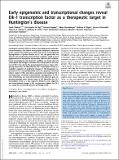Early epigenomic and transcriptional changes reveal Elk-1 transcription factor as a therapeutic target in Huntington’s disease
Author(s)
Yildirim, Ferah; Ng, Christopher; Kappes, Vincent; Ehrenberger, Tobias; Rigby, Siobhan K.; Stivanello, Victoria; Gipson, Theresa A.; Soltis, Anthony R.; Vanhoutte, Peter; Caboche, Jocelyne; Housman, David E.; Fraenkel, Ernest; ... Show more Show less
DownloadPublished version (2.461Mb)
Terms of use
Metadata
Show full item recordAbstract
Huntington’s disease (HD) is a chronic neurodegenerative disorder characterized by a late clinical onset despite ubiquitous expression of the mutant Huntingtin gene (HTT) from birth. Transcriptional dysregulation is a pivotal feature of HD. Yet, the genes that are altered in the prodromal period and their regulators, which present opportunities for therapeutic intervention, remain to be elucidated. Using transcriptional and chromatin profiling, we found aberrant transcription and changes in histone H3K27acetylation in the striatum of R6/1 mice during the presymptomatic disease stages. Integrating these data, we identified the Elk-1 transcription factor as a candidate regulator of prodromal changes in HD. Exogenous expression of Elk-1 exerted beneficial effects in a primary striatal cell culture model of HD, and adeno-associated virus-mediated Elk-1 overexpression alleviated transcriptional dysregulation in R6/1 mice. Collectively, our work demonstrates that aberrant gene expression precedes overt disease onset in HD, identifies the Elk-1 transcription factor as a key regulator linked to early epigenetic and transcriptional changes in HD, and presents evidence for Elk-1 as a target for alleviating molecular pathology in HD. Keywords: Huntington’s disease; neurodegeneration; transcriptional dysregulation; epigenomics; gene therapy
Date issued
2019-11Department
Massachusetts Institute of Technology. Department of Biology; Massachusetts Institute of Technology. Department of Biological Engineering; Koch Institute for Integrative Cancer Research at MITJournal
Proceedings of the National Academy of Sciences of the United States of America
Publisher
Proceedings of the National Academy of Sciences
Citation
Yildirim, Ferah et al. "Early epigenomic and transcriptional changes reveal Elk-1 transcription factor as a therapeutic target in Huntington’s disease." Proceedings of the National Academy of Sciences of the United States of America 116, 49 (December 2019): 24840-24851 © 2019 PNAS
Version: Final published version
ISSN
0027-8424
1091-6490